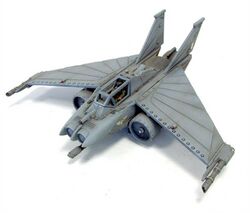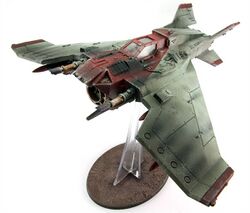Lightning Fighter: Difference between revisions
| Line 9: | Line 9: | ||
=== Voss Pattern === | === Voss Pattern === | ||
In December 2012, Forge World retired the old Lightning model and released a | In December 2012, Forge World retired the old Lightning model and released a more advanced-looking "Voss Pattern" Lightning Strike Fighter. It features slightly sturdier-looking wings, a beefier, single engine intake, and a more streamlined nose (especially compared to the goofy "headlights" of the original). | ||
== Real Life == | == Real Life == | ||
Revision as of 23:27, 7 January 2018


The Lightning is the Imperial Navy's premiere air superiority fighter, with agility unmatched by any other Imperial flyer thanks to its distinctive forward-swept wings. Though its primary weapons are a long-barreled autocannon and twin-linked lascannons for engaging enemy aircraft, it can be fitted with one of several varieties of missiles and bombs to specialize in anti-armor, anti-infantry, or anti-air operations.
Lightning 'Strike'
The 'Strike' variant Lightning is the same airframe, but with more missiles or bombs instead of the underslung autocannon.
Voss Pattern
In December 2012, Forge World retired the old Lightning model and released a more advanced-looking "Voss Pattern" Lightning Strike Fighter. It features slightly sturdier-looking wings, a beefier, single engine intake, and a more streamlined nose (especially compared to the goofy "headlights" of the original).
Real Life
Forward-swept wings have been tried on real experimental aircraft, and they do confer some benefits, like enhanced maneuverability, improved airflow and the possibility of a more compact airframe. It also comes with the drawbacks of instability (though modern avionics can make the minute corrections required to keep the aircraft steady) and a risk of the wings twisting themselves to pieces at high speeds. These issues meant that it took about 50 years from the idea's conception before prototype high-performance fighter aircraft with forward-swept wings could be built (the Grumman X-29 in 1984, and the Sukhoi Su-47 in 1997, and both of those ended up being scrapped anyway). For comparison, it took the Adeptus Mechanicus over five hundred years to fix these issues in the Lightning, and they didn't even come up with the idea themselves -- they had to find the STC first. On the flipside, the people who were trying to fix them were probably being shot at by their own colleagues, so it's rather notable they managed to fix them at all.